Accounting Analysis: Telstra's Ooyala Sale and Financial Reporting
VerifiedAdded on 2022/10/02
|9
|1669
|182
Report
AI Summary
This report analyzes Telstra's financial reporting related to the sale of its video streaming company, Ooyala. The analysis covers the accounting treatments applied in accordance with AASB 10, including the recognition of losses from the sale, income tax expenses, and disclosures in the notes to the financial statements. The report examines Telstra's compliance with accounting standards regarding the presentation of controlled entities, impairment adjustments, and the overall impact of the Ooyala sale on Telstra's financial statements. Furthermore, it highlights the benefits of this financial information for stakeholders such as investors and analysts, providing insights into the company's performance, asset management, and transparency. The report also discusses how the information helps users assess the financial health of the parent entity, the impact of subsidiary acquisitions and disposals, and the overall financial position of the company.
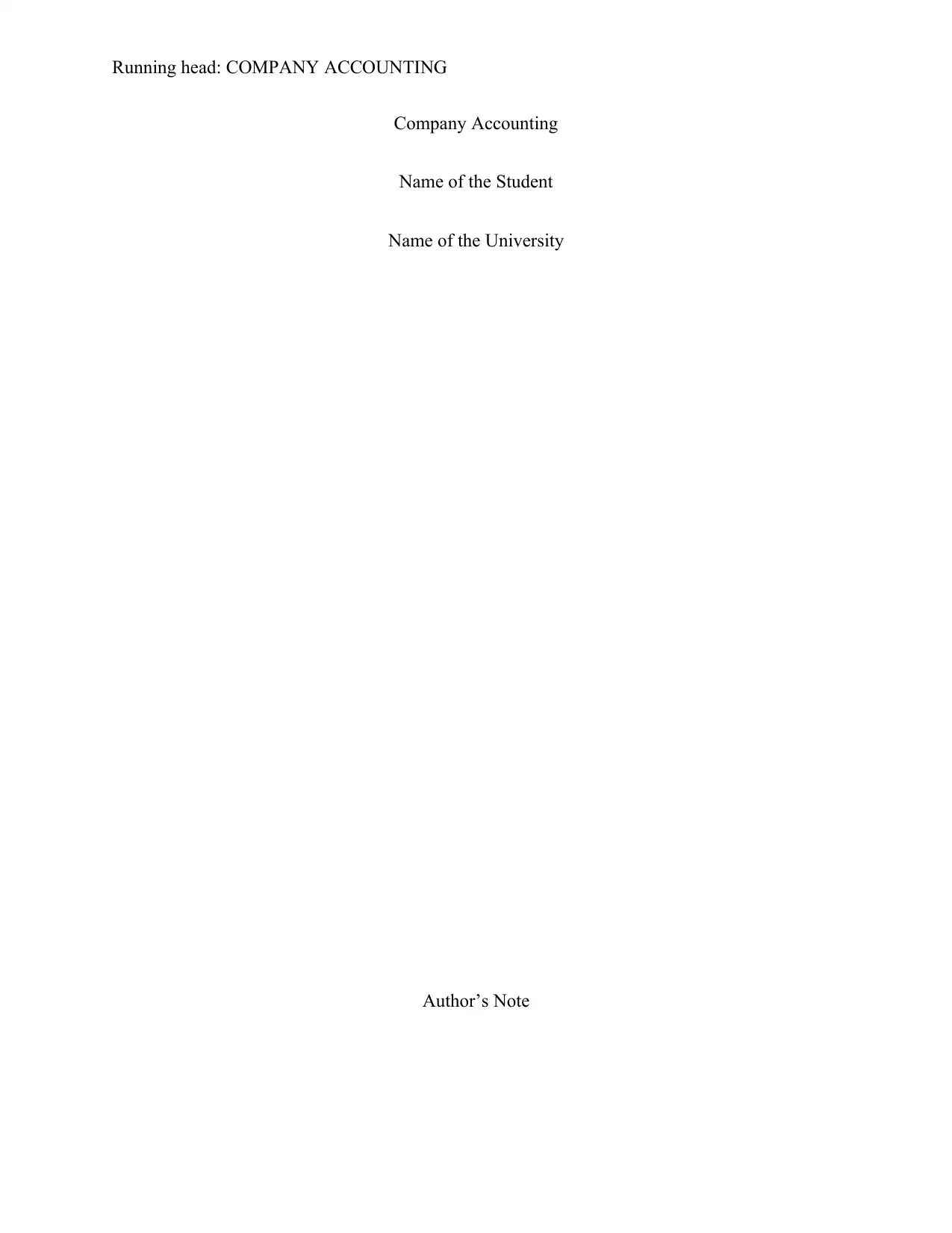
Running head: COMPANY ACCOUNTING
Company Accounting
Name of the Student
Name of the University
Author’s Note
Company Accounting
Name of the Student
Name of the University
Author’s Note
Paraphrase This Document
Need a fresh take? Get an instant paraphrase of this document with our AI Paraphraser
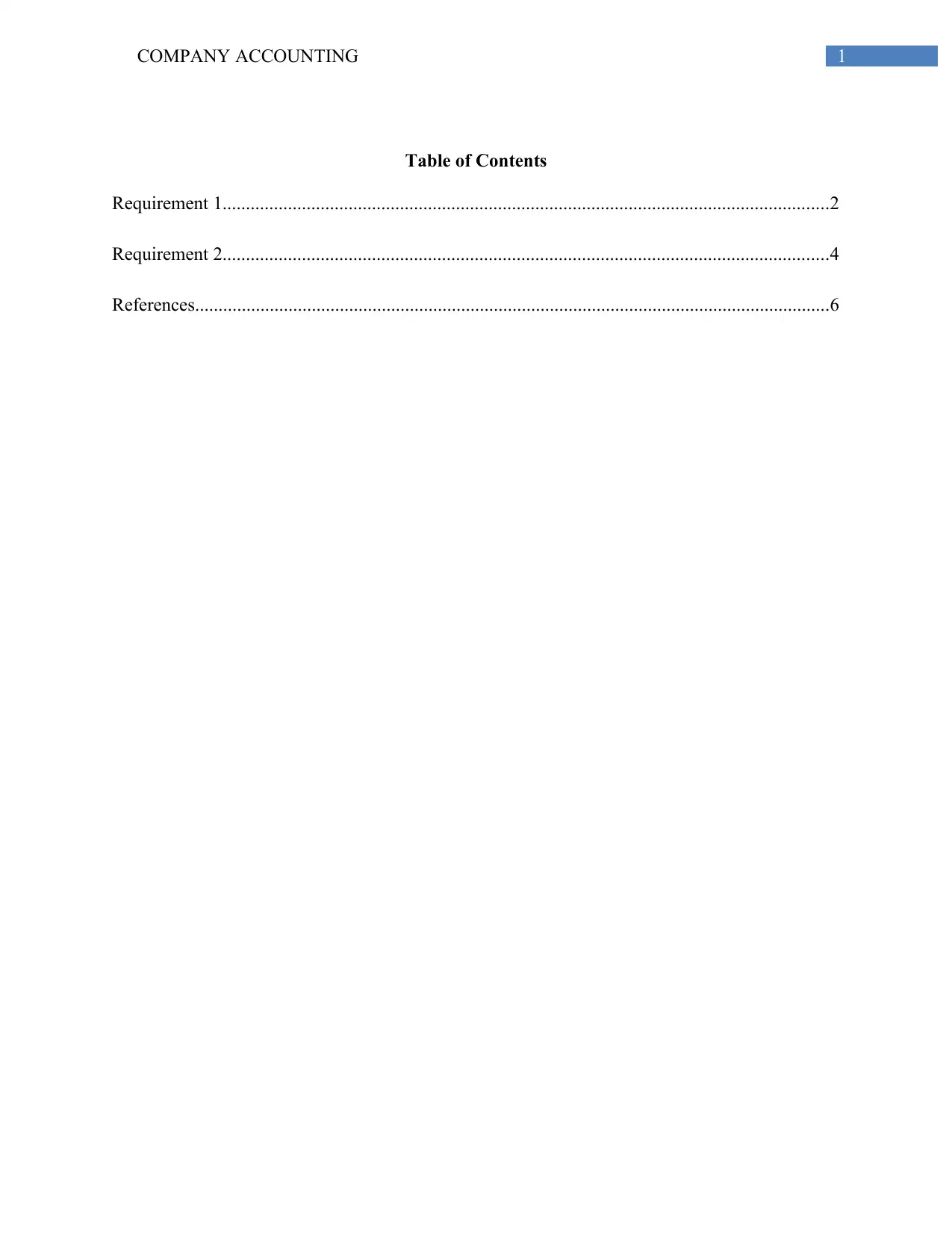
1COMPANY ACCOUNTING
Table of Contents
Requirement 1..................................................................................................................................2
Requirement 2..................................................................................................................................4
References........................................................................................................................................6
Table of Contents
Requirement 1..................................................................................................................................2
Requirement 2..................................................................................................................................4
References........................................................................................................................................6
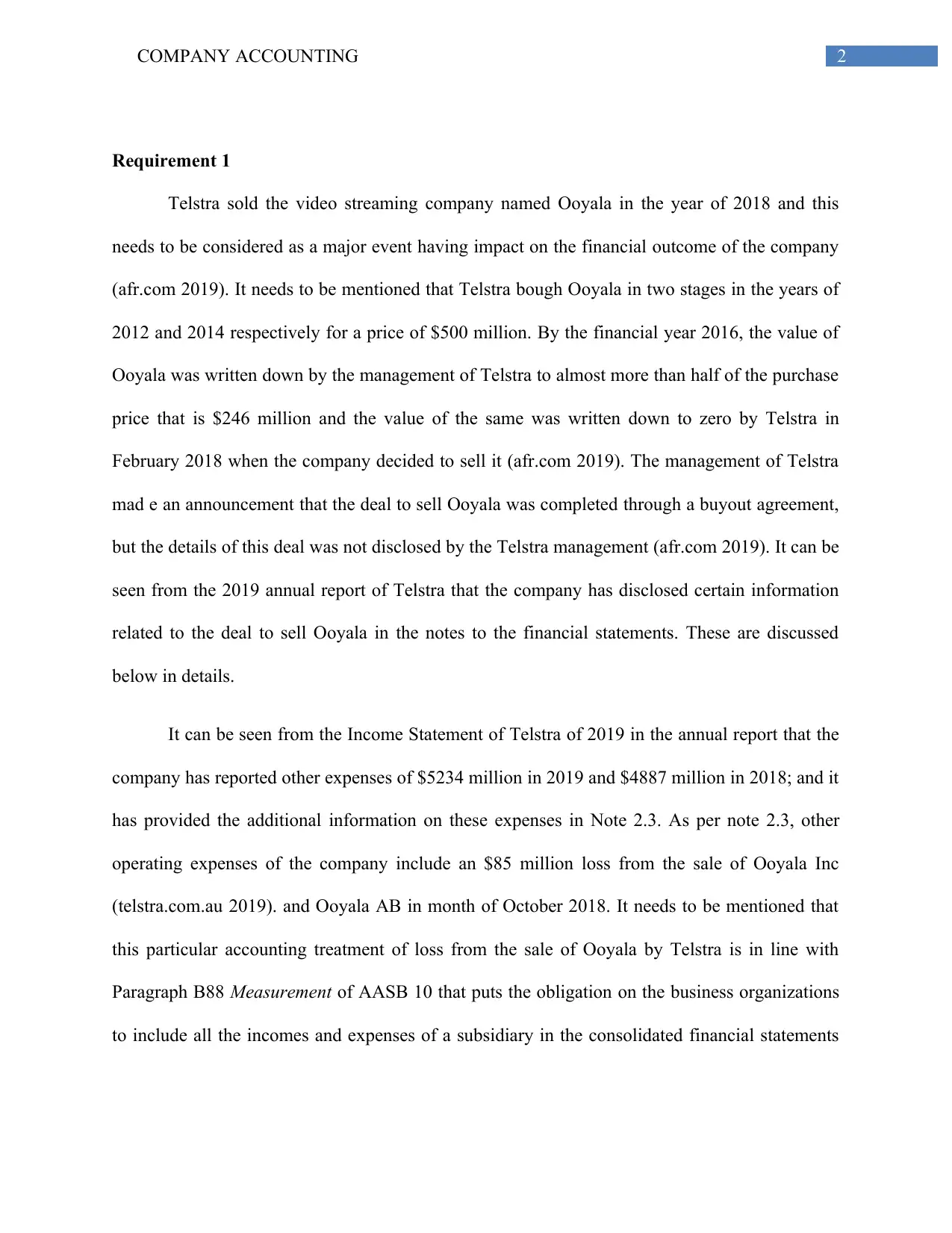
2COMPANY ACCOUNTING
Requirement 1
Telstra sold the video streaming company named Ooyala in the year of 2018 and this
needs to be considered as a major event having impact on the financial outcome of the company
(afr.com 2019). It needs to be mentioned that Telstra bough Ooyala in two stages in the years of
2012 and 2014 respectively for a price of $500 million. By the financial year 2016, the value of
Ooyala was written down by the management of Telstra to almost more than half of the purchase
price that is $246 million and the value of the same was written down to zero by Telstra in
February 2018 when the company decided to sell it (afr.com 2019). The management of Telstra
mad e an announcement that the deal to sell Ooyala was completed through a buyout agreement,
but the details of this deal was not disclosed by the Telstra management (afr.com 2019). It can be
seen from the 2019 annual report of Telstra that the company has disclosed certain information
related to the deal to sell Ooyala in the notes to the financial statements. These are discussed
below in details.
It can be seen from the Income Statement of Telstra of 2019 in the annual report that the
company has reported other expenses of $5234 million in 2019 and $4887 million in 2018; and it
has provided the additional information on these expenses in Note 2.3. As per note 2.3, other
operating expenses of the company include an $85 million loss from the sale of Ooyala Inc
(telstra.com.au 2019). and Ooyala AB in month of October 2018. It needs to be mentioned that
this particular accounting treatment of loss from the sale of Ooyala by Telstra is in line with
Paragraph B88 Measurement of AASB 10 that puts the obligation on the business organizations
to include all the incomes and expenses of a subsidiary in the consolidated financial statements
Requirement 1
Telstra sold the video streaming company named Ooyala in the year of 2018 and this
needs to be considered as a major event having impact on the financial outcome of the company
(afr.com 2019). It needs to be mentioned that Telstra bough Ooyala in two stages in the years of
2012 and 2014 respectively for a price of $500 million. By the financial year 2016, the value of
Ooyala was written down by the management of Telstra to almost more than half of the purchase
price that is $246 million and the value of the same was written down to zero by Telstra in
February 2018 when the company decided to sell it (afr.com 2019). The management of Telstra
mad e an announcement that the deal to sell Ooyala was completed through a buyout agreement,
but the details of this deal was not disclosed by the Telstra management (afr.com 2019). It can be
seen from the 2019 annual report of Telstra that the company has disclosed certain information
related to the deal to sell Ooyala in the notes to the financial statements. These are discussed
below in details.
It can be seen from the Income Statement of Telstra of 2019 in the annual report that the
company has reported other expenses of $5234 million in 2019 and $4887 million in 2018; and it
has provided the additional information on these expenses in Note 2.3. As per note 2.3, other
operating expenses of the company include an $85 million loss from the sale of Ooyala Inc
(telstra.com.au 2019). and Ooyala AB in month of October 2018. It needs to be mentioned that
this particular accounting treatment of loss from the sale of Ooyala by Telstra is in line with
Paragraph B88 Measurement of AASB 10 that puts the obligation on the business organizations
to include all the incomes and expenses of a subsidiary in the consolidated financial statements
⊘ This is a preview!⊘
Do you want full access?
Subscribe today to unlock all pages.

Trusted by 1+ million students worldwide
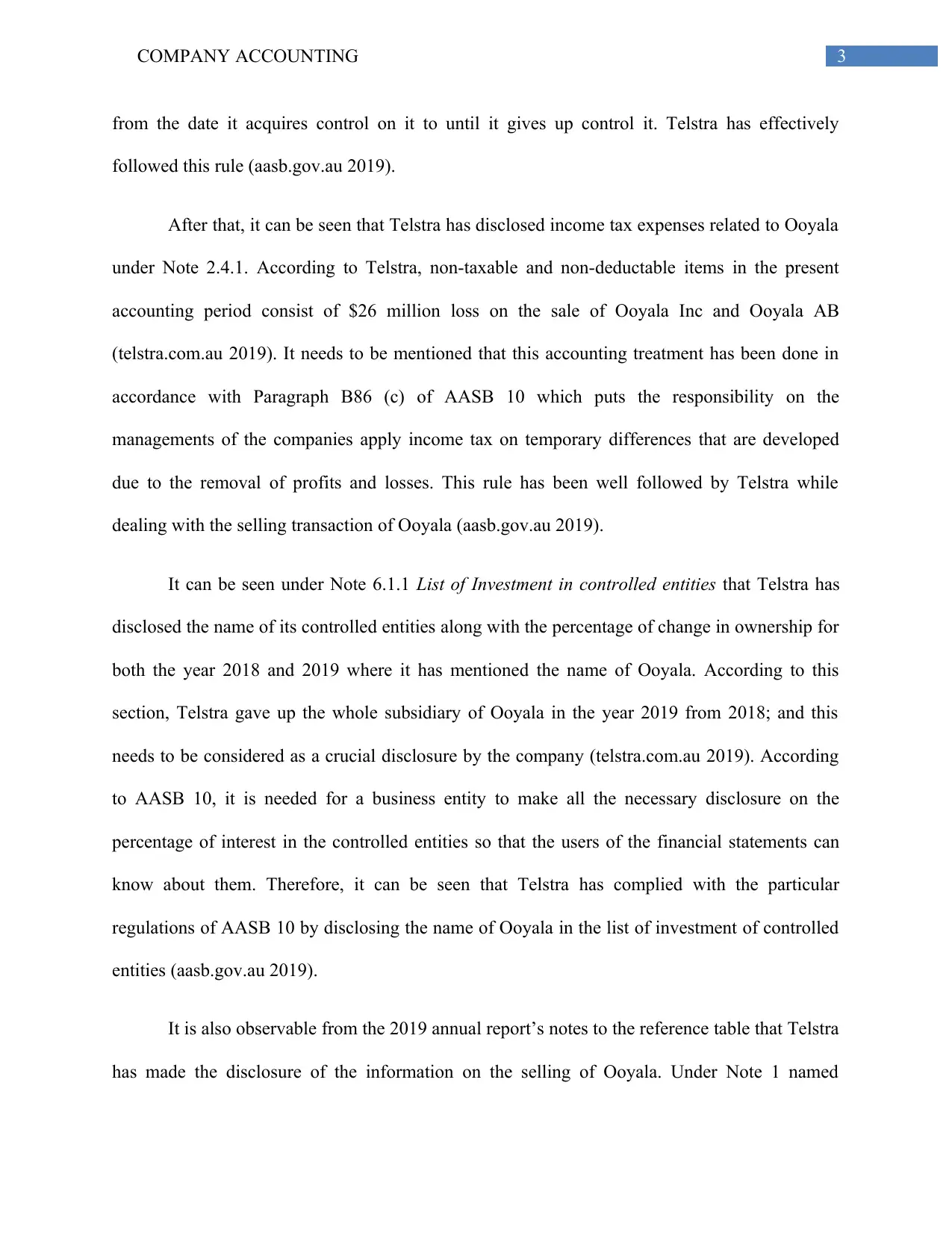
3COMPANY ACCOUNTING
from the date it acquires control on it to until it gives up control it. Telstra has effectively
followed this rule (aasb.gov.au 2019).
After that, it can be seen that Telstra has disclosed income tax expenses related to Ooyala
under Note 2.4.1. According to Telstra, non-taxable and non-deductable items in the present
accounting period consist of $26 million loss on the sale of Ooyala Inc and Ooyala AB
(telstra.com.au 2019). It needs to be mentioned that this accounting treatment has been done in
accordance with Paragraph B86 (c) of AASB 10 which puts the responsibility on the
managements of the companies apply income tax on temporary differences that are developed
due to the removal of profits and losses. This rule has been well followed by Telstra while
dealing with the selling transaction of Ooyala (aasb.gov.au 2019).
It can be seen under Note 6.1.1 List of Investment in controlled entities that Telstra has
disclosed the name of its controlled entities along with the percentage of change in ownership for
both the year 2018 and 2019 where it has mentioned the name of Ooyala. According to this
section, Telstra gave up the whole subsidiary of Ooyala in the year 2019 from 2018; and this
needs to be considered as a crucial disclosure by the company (telstra.com.au 2019). According
to AASB 10, it is needed for a business entity to make all the necessary disclosure on the
percentage of interest in the controlled entities so that the users of the financial statements can
know about them. Therefore, it can be seen that Telstra has complied with the particular
regulations of AASB 10 by disclosing the name of Ooyala in the list of investment of controlled
entities (aasb.gov.au 2019).
It is also observable from the 2019 annual report’s notes to the reference table that Telstra
has made the disclosure of the information on the selling of Ooyala. Under Note 1 named
from the date it acquires control on it to until it gives up control it. Telstra has effectively
followed this rule (aasb.gov.au 2019).
After that, it can be seen that Telstra has disclosed income tax expenses related to Ooyala
under Note 2.4.1. According to Telstra, non-taxable and non-deductable items in the present
accounting period consist of $26 million loss on the sale of Ooyala Inc and Ooyala AB
(telstra.com.au 2019). It needs to be mentioned that this accounting treatment has been done in
accordance with Paragraph B86 (c) of AASB 10 which puts the responsibility on the
managements of the companies apply income tax on temporary differences that are developed
due to the removal of profits and losses. This rule has been well followed by Telstra while
dealing with the selling transaction of Ooyala (aasb.gov.au 2019).
It can be seen under Note 6.1.1 List of Investment in controlled entities that Telstra has
disclosed the name of its controlled entities along with the percentage of change in ownership for
both the year 2018 and 2019 where it has mentioned the name of Ooyala. According to this
section, Telstra gave up the whole subsidiary of Ooyala in the year 2019 from 2018; and this
needs to be considered as a crucial disclosure by the company (telstra.com.au 2019). According
to AASB 10, it is needed for a business entity to make all the necessary disclosure on the
percentage of interest in the controlled entities so that the users of the financial statements can
know about them. Therefore, it can be seen that Telstra has complied with the particular
regulations of AASB 10 by disclosing the name of Ooyala in the list of investment of controlled
entities (aasb.gov.au 2019).
It is also observable from the 2019 annual report’s notes to the reference table that Telstra
has made the disclosure of the information on the selling of Ooyala. Under Note 1 named
Paraphrase This Document
Need a fresh take? Get an instant paraphrase of this document with our AI Paraphraser
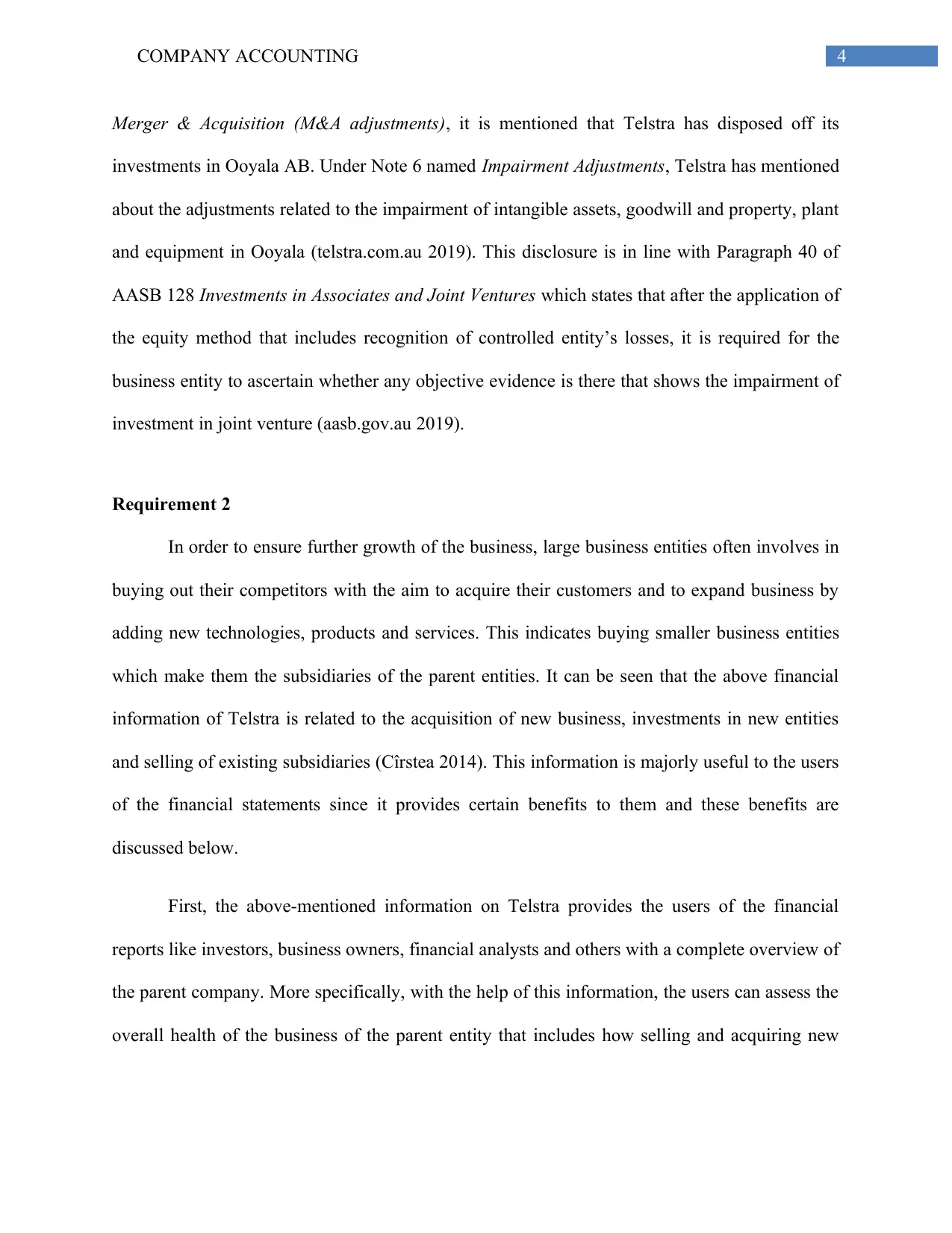
4COMPANY ACCOUNTING
Merger & Acquisition (M&A adjustments), it is mentioned that Telstra has disposed off its
investments in Ooyala AB. Under Note 6 named Impairment Adjustments, Telstra has mentioned
about the adjustments related to the impairment of intangible assets, goodwill and property, plant
and equipment in Ooyala (telstra.com.au 2019). This disclosure is in line with Paragraph 40 of
AASB 128 Investments in Associates and Joint Ventures which states that after the application of
the equity method that includes recognition of controlled entity’s losses, it is required for the
business entity to ascertain whether any objective evidence is there that shows the impairment of
investment in joint venture (aasb.gov.au 2019).
Requirement 2
In order to ensure further growth of the business, large business entities often involves in
buying out their competitors with the aim to acquire their customers and to expand business by
adding new technologies, products and services. This indicates buying smaller business entities
which make them the subsidiaries of the parent entities. It can be seen that the above financial
information of Telstra is related to the acquisition of new business, investments in new entities
and selling of existing subsidiaries (Cîrstea 2014). This information is majorly useful to the users
of the financial statements since it provides certain benefits to them and these benefits are
discussed below.
First, the above-mentioned information on Telstra provides the users of the financial
reports like investors, business owners, financial analysts and others with a complete overview of
the parent company. More specifically, with the help of this information, the users can assess the
overall health of the business of the parent entity that includes how selling and acquiring new
Merger & Acquisition (M&A adjustments), it is mentioned that Telstra has disposed off its
investments in Ooyala AB. Under Note 6 named Impairment Adjustments, Telstra has mentioned
about the adjustments related to the impairment of intangible assets, goodwill and property, plant
and equipment in Ooyala (telstra.com.au 2019). This disclosure is in line with Paragraph 40 of
AASB 128 Investments in Associates and Joint Ventures which states that after the application of
the equity method that includes recognition of controlled entity’s losses, it is required for the
business entity to ascertain whether any objective evidence is there that shows the impairment of
investment in joint venture (aasb.gov.au 2019).
Requirement 2
In order to ensure further growth of the business, large business entities often involves in
buying out their competitors with the aim to acquire their customers and to expand business by
adding new technologies, products and services. This indicates buying smaller business entities
which make them the subsidiaries of the parent entities. It can be seen that the above financial
information of Telstra is related to the acquisition of new business, investments in new entities
and selling of existing subsidiaries (Cîrstea 2014). This information is majorly useful to the users
of the financial statements since it provides certain benefits to them and these benefits are
discussed below.
First, the above-mentioned information on Telstra provides the users of the financial
reports like investors, business owners, financial analysts and others with a complete overview of
the parent company. More specifically, with the help of this information, the users can assess the
overall health of the business of the parent entity that includes how selling and acquiring new
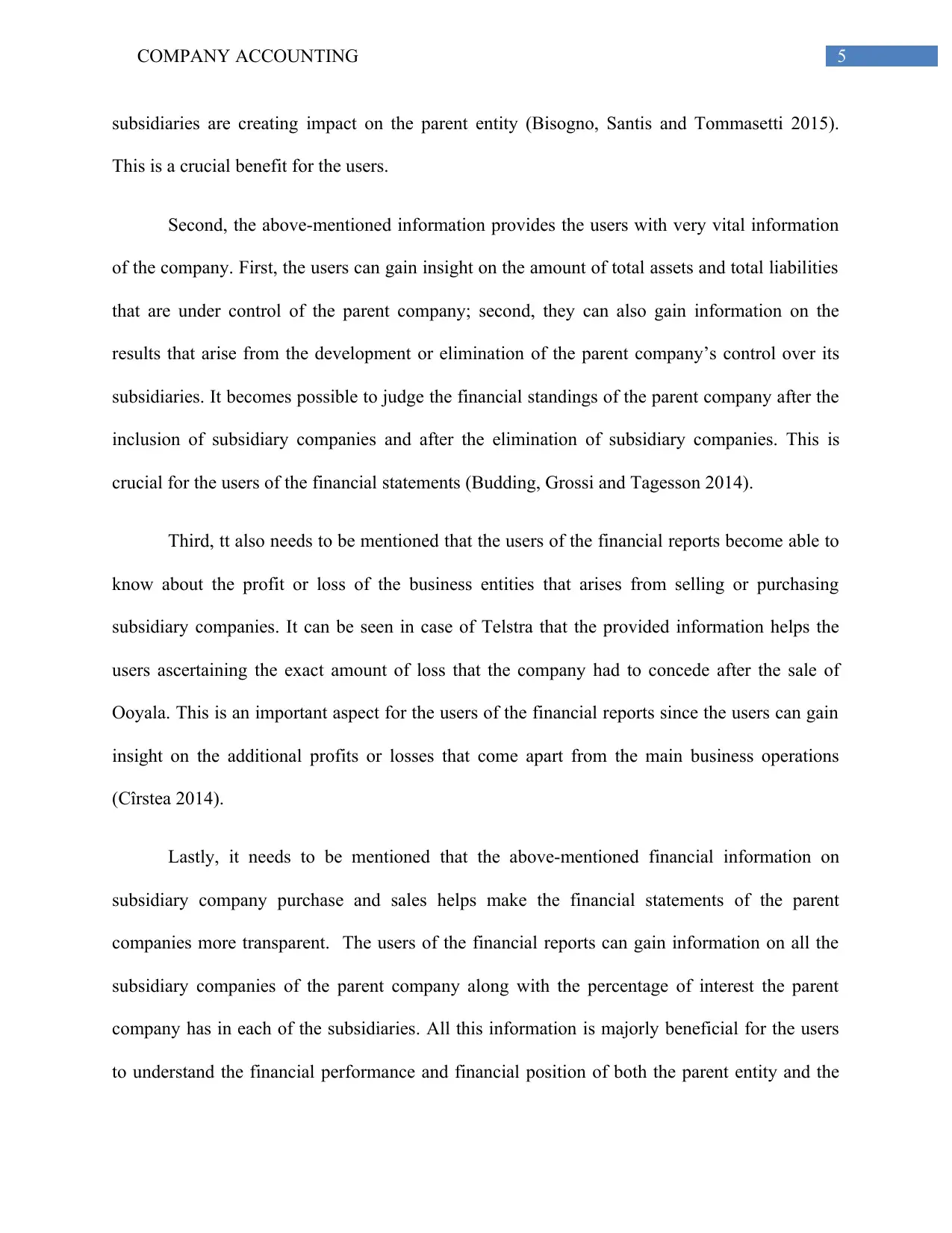
5COMPANY ACCOUNTING
subsidiaries are creating impact on the parent entity (Bisogno, Santis and Tommasetti 2015).
This is a crucial benefit for the users.
Second, the above-mentioned information provides the users with very vital information
of the company. First, the users can gain insight on the amount of total assets and total liabilities
that are under control of the parent company; second, they can also gain information on the
results that arise from the development or elimination of the parent company’s control over its
subsidiaries. It becomes possible to judge the financial standings of the parent company after the
inclusion of subsidiary companies and after the elimination of subsidiary companies. This is
crucial for the users of the financial statements (Budding, Grossi and Tagesson 2014).
Third, tt also needs to be mentioned that the users of the financial reports become able to
know about the profit or loss of the business entities that arises from selling or purchasing
subsidiary companies. It can be seen in case of Telstra that the provided information helps the
users ascertaining the exact amount of loss that the company had to concede after the sale of
Ooyala. This is an important aspect for the users of the financial reports since the users can gain
insight on the additional profits or losses that come apart from the main business operations
(Cîrstea 2014).
Lastly, it needs to be mentioned that the above-mentioned financial information on
subsidiary company purchase and sales helps make the financial statements of the parent
companies more transparent. The users of the financial reports can gain information on all the
subsidiary companies of the parent company along with the percentage of interest the parent
company has in each of the subsidiaries. All this information is majorly beneficial for the users
to understand the financial performance and financial position of both the parent entity and the
subsidiaries are creating impact on the parent entity (Bisogno, Santis and Tommasetti 2015).
This is a crucial benefit for the users.
Second, the above-mentioned information provides the users with very vital information
of the company. First, the users can gain insight on the amount of total assets and total liabilities
that are under control of the parent company; second, they can also gain information on the
results that arise from the development or elimination of the parent company’s control over its
subsidiaries. It becomes possible to judge the financial standings of the parent company after the
inclusion of subsidiary companies and after the elimination of subsidiary companies. This is
crucial for the users of the financial statements (Budding, Grossi and Tagesson 2014).
Third, tt also needs to be mentioned that the users of the financial reports become able to
know about the profit or loss of the business entities that arises from selling or purchasing
subsidiary companies. It can be seen in case of Telstra that the provided information helps the
users ascertaining the exact amount of loss that the company had to concede after the sale of
Ooyala. This is an important aspect for the users of the financial reports since the users can gain
insight on the additional profits or losses that come apart from the main business operations
(Cîrstea 2014).
Lastly, it needs to be mentioned that the above-mentioned financial information on
subsidiary company purchase and sales helps make the financial statements of the parent
companies more transparent. The users of the financial reports can gain information on all the
subsidiary companies of the parent company along with the percentage of interest the parent
company has in each of the subsidiaries. All this information is majorly beneficial for the users
to understand the financial performance and financial position of both the parent entity and the
⊘ This is a preview!⊘
Do you want full access?
Subscribe today to unlock all pages.

Trusted by 1+ million students worldwide
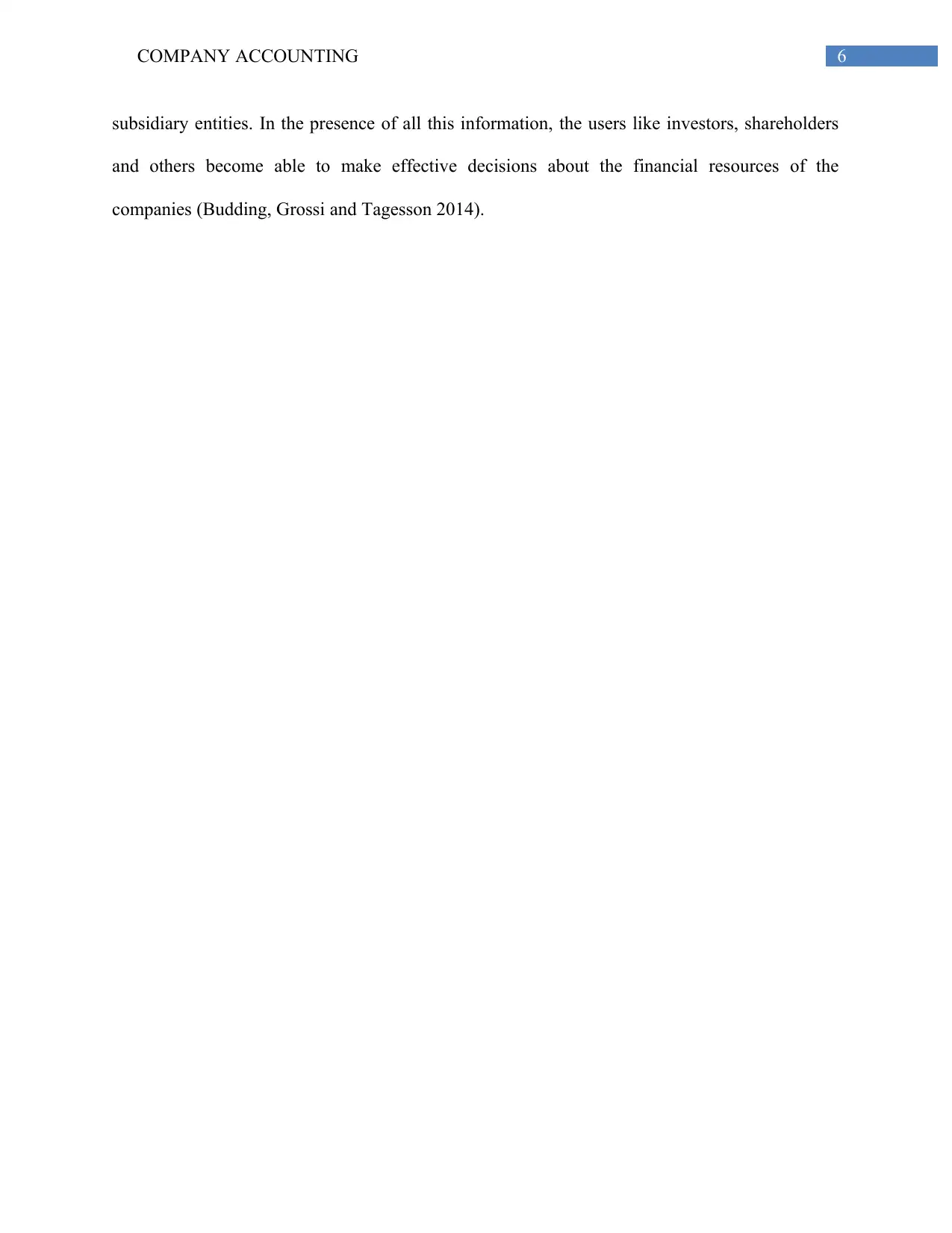
6COMPANY ACCOUNTING
subsidiary entities. In the presence of all this information, the users like investors, shareholders
and others become able to make effective decisions about the financial resources of the
companies (Budding, Grossi and Tagesson 2014).
subsidiary entities. In the presence of all this information, the users like investors, shareholders
and others become able to make effective decisions about the financial resources of the
companies (Budding, Grossi and Tagesson 2014).
Paraphrase This Document
Need a fresh take? Get an instant paraphrase of this document with our AI Paraphraser
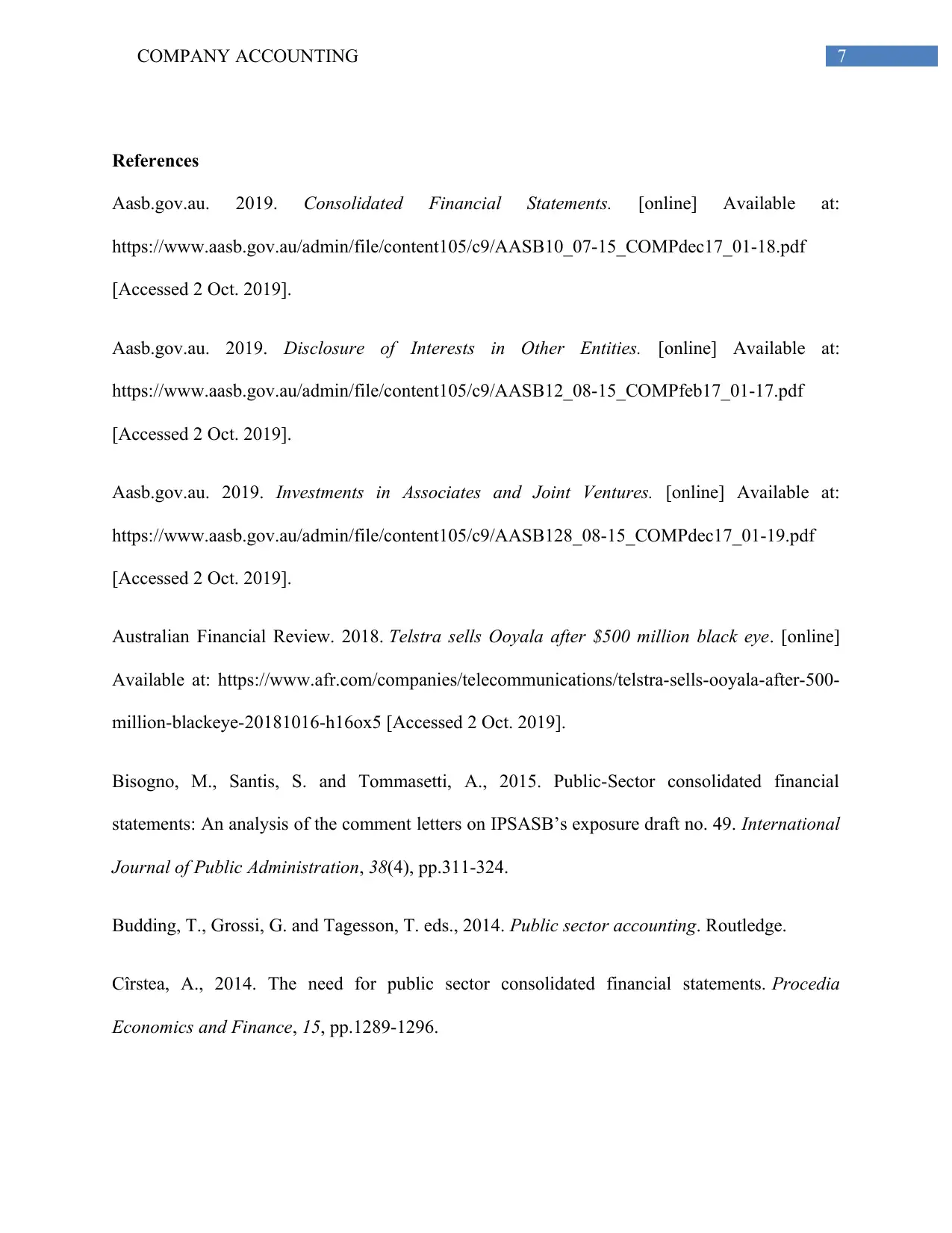
7COMPANY ACCOUNTING
References
Aasb.gov.au. 2019. Consolidated Financial Statements. [online] Available at:
https://www.aasb.gov.au/admin/file/content105/c9/AASB10_07-15_COMPdec17_01-18.pdf
[Accessed 2 Oct. 2019].
Aasb.gov.au. 2019. Disclosure of Interests in Other Entities. [online] Available at:
https://www.aasb.gov.au/admin/file/content105/c9/AASB12_08-15_COMPfeb17_01-17.pdf
[Accessed 2 Oct. 2019].
Aasb.gov.au. 2019. Investments in Associates and Joint Ventures. [online] Available at:
https://www.aasb.gov.au/admin/file/content105/c9/AASB128_08-15_COMPdec17_01-19.pdf
[Accessed 2 Oct. 2019].
Australian Financial Review. 2018. Telstra sells Ooyala after $500 million black eye. [online]
Available at: https://www.afr.com/companies/telecommunications/telstra-sells-ooyala-after-500-
million-blackeye-20181016-h16ox5 [Accessed 2 Oct. 2019].
Bisogno, M., Santis, S. and Tommasetti, A., 2015. Public-Sector consolidated financial
statements: An analysis of the comment letters on IPSASB’s exposure draft no. 49. International
Journal of Public Administration, 38(4), pp.311-324.
Budding, T., Grossi, G. and Tagesson, T. eds., 2014. Public sector accounting. Routledge.
Cîrstea, A., 2014. The need for public sector consolidated financial statements. Procedia
Economics and Finance, 15, pp.1289-1296.
References
Aasb.gov.au. 2019. Consolidated Financial Statements. [online] Available at:
https://www.aasb.gov.au/admin/file/content105/c9/AASB10_07-15_COMPdec17_01-18.pdf
[Accessed 2 Oct. 2019].
Aasb.gov.au. 2019. Disclosure of Interests in Other Entities. [online] Available at:
https://www.aasb.gov.au/admin/file/content105/c9/AASB12_08-15_COMPfeb17_01-17.pdf
[Accessed 2 Oct. 2019].
Aasb.gov.au. 2019. Investments in Associates and Joint Ventures. [online] Available at:
https://www.aasb.gov.au/admin/file/content105/c9/AASB128_08-15_COMPdec17_01-19.pdf
[Accessed 2 Oct. 2019].
Australian Financial Review. 2018. Telstra sells Ooyala after $500 million black eye. [online]
Available at: https://www.afr.com/companies/telecommunications/telstra-sells-ooyala-after-500-
million-blackeye-20181016-h16ox5 [Accessed 2 Oct. 2019].
Bisogno, M., Santis, S. and Tommasetti, A., 2015. Public-Sector consolidated financial
statements: An analysis of the comment letters on IPSASB’s exposure draft no. 49. International
Journal of Public Administration, 38(4), pp.311-324.
Budding, T., Grossi, G. and Tagesson, T. eds., 2014. Public sector accounting. Routledge.
Cîrstea, A., 2014. The need for public sector consolidated financial statements. Procedia
Economics and Finance, 15, pp.1289-1296.
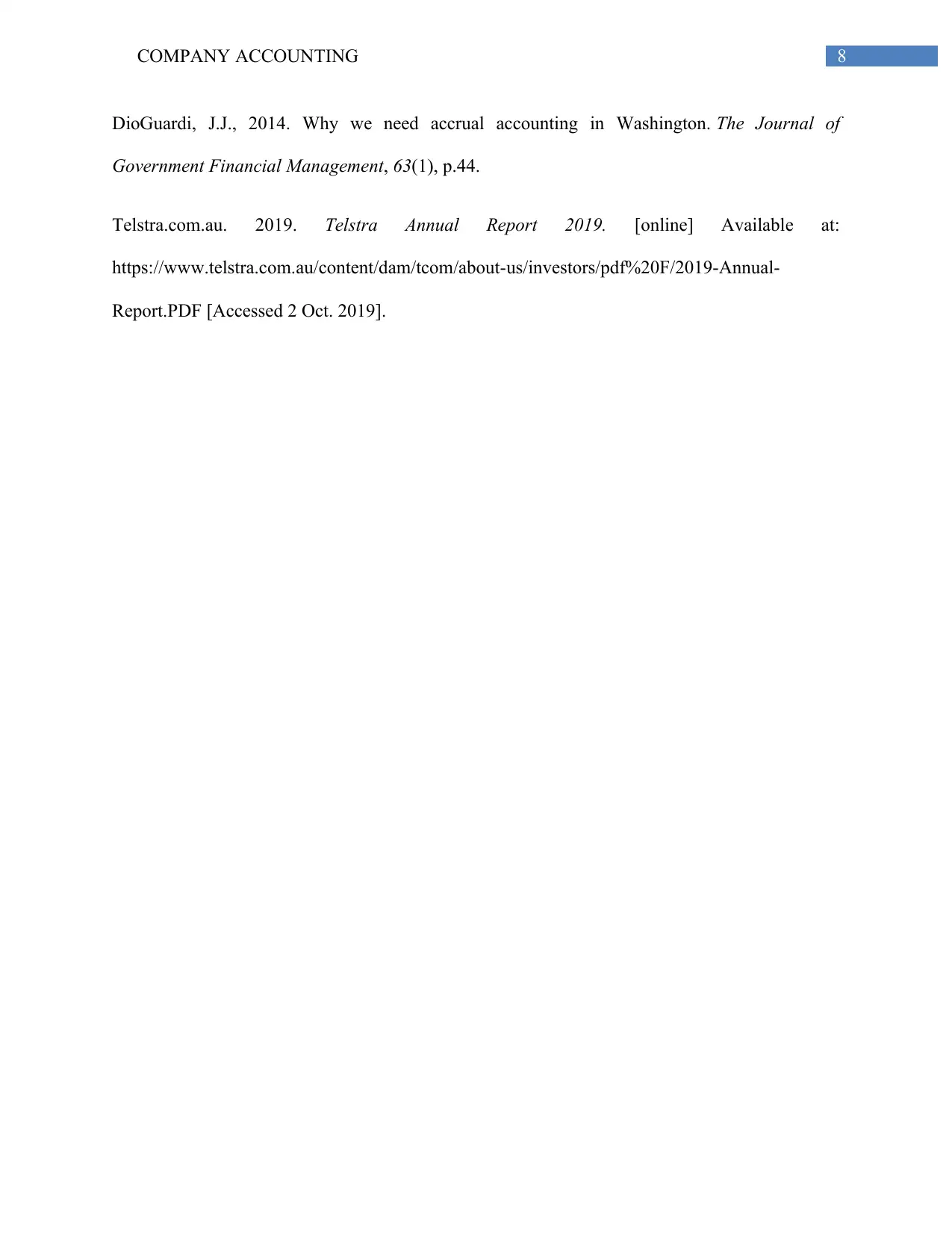
8COMPANY ACCOUNTING
DioGuardi, J.J., 2014. Why we need accrual accounting in Washington. The Journal of
Government Financial Management, 63(1), p.44.
Telstra.com.au. 2019. Telstra Annual Report 2019. [online] Available at:
https://www.telstra.com.au/content/dam/tcom/about-us/investors/pdf%20F/2019-Annual-
Report.PDF [Accessed 2 Oct. 2019].
DioGuardi, J.J., 2014. Why we need accrual accounting in Washington. The Journal of
Government Financial Management, 63(1), p.44.
Telstra.com.au. 2019. Telstra Annual Report 2019. [online] Available at:
https://www.telstra.com.au/content/dam/tcom/about-us/investors/pdf%20F/2019-Annual-
Report.PDF [Accessed 2 Oct. 2019].
⊘ This is a preview!⊘
Do you want full access?
Subscribe today to unlock all pages.

Trusted by 1+ million students worldwide
1 out of 9
Related Documents
Your All-in-One AI-Powered Toolkit for Academic Success.
+13062052269
info@desklib.com
Available 24*7 on WhatsApp / Email
![[object Object]](/_next/static/media/star-bottom.7253800d.svg)
Unlock your academic potential
Copyright © 2020–2025 A2Z Services. All Rights Reserved. Developed and managed by ZUCOL.





